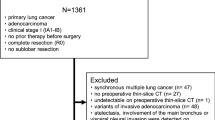Abstract
Background
In clinical T1N0 peripheral lung cancers, lymph node upstaging is occasionally encountered postoperatively. However, nodal upstaging is rare in lung cancers presenting as ground-glass opacities. The aim of this study was to determine if lymph node upstaging could be reliably extrapolated from parameters such the consolidation/tumor ratio of chest computed tomography.
Methods
We conducted a retrospective study of 486 patients treated for peripheral clinical T1N0 non-small cell lung cancer, each undergoing lobectomy with mediastinal lymph node dissection. We compared preoperative variables in the pathologic N0 and nodal upstaging groups, analyzing such variables to determine factors predictive of lymph node upstaging.
Results
Of the 486 patients studied, lymph node upstaging occurred in 42 (8.6%). In the upstaging group, the mean nodule diameter exceeded that of the pathologic N0 group (2.3 vs 1.9 cm, respectively; p < 0.001), and the mean consolidation/tumor ratio was larger in the upstaging group than the pN0 group (0.95 vs 0.68, respectively; p < 0.001). Nodule diameter and consolidation/tumor ratio emerged as significant predictive factors for lymph node upstaging after surgery in a multivariate analysis (hazard ratio [HR] 2.259, p = 0.039; HR 173.645, p = 0.001, respectively).
Conclusions
Consolidation/tumor ratio and nodule diameter are significant predictive factors of postoperative lymph node upstaging. The higher the consolidation/tumor ratio and smaller the nodule diameter, the less likely the occurrence of postoperative lymph upstaging would be in clinical T1N0 peripheral non-small cell lung cancer.



Similar content being viewed by others
References
Torre LA, Siegel RL, Jemal A (2016) Lung Cancer Statistics. Adv Exp Med Biol 893:1–19
Aberle DR, Adams AM, Berg CD et al (2011) Reduced lung-cancer mortality with low-dose computed tomographic screening. N Engl J Med 365:395–409
Travis WD, Brambilla E, Noguchi M et al (2011) International association for the study of lung cancer/american thoracic society/european respiratory society international multidisciplinary classification of lung adenocarcinoma. J Thorac Oncol 6:244–285
Wilshire CL, Louie BE, Manning KA et al (2015) Radiologic evaluation of small lepidic adenocarcinomas to guide decision making in surgical resection. Ann Thorac Surg 100:979–988
Travis WD, Brambilla E, Nicholson AG et al (2015) The 2015 World Health Organization classification of lung tumors: impact of genetic, clinical and radiologic advances since the 2004 classification. J Thorac Oncol 10:1243–1260
Eguchi T, Kadota K, Park BJ et al (2014) The new IASLC-ATS-ERS lung adenocarcinoma classification: what the surgeon should know. Semin Thorac Cardiovasc Surg 26:210–222
Hattori A, Matsunaga T, Takamochi K et al (2017) Importance of ground glass opacity component in clinical stage IA radiologic invasive lung cancer. Ann Thorac Surg 104:313–320
Nishio W, Yoshimura M, Maniwa Y et al (2016) Re-assessment of intentional extended segmentectomy for clinical T1aN0 non-small cell lung cancer. Ann Thorac Surg 102:1702–1710
De Leyn P, Dooms C, Kuzdzal J et al (2014) Revised ESTS guidelines for preoperative mediastinal lymph node staging for non-small-cell lung cancer. Eur J Cardiothorac Surg 45:787–798
Hansell DM, Bankier AA, MacMahon H et al (2008) Fleischner society: glossary of terms for thoracic imaging. Radiology 246:697–722
Lu P, Sun Y, Sun Y et al (2014) The role of (18)F-FDG PET/CT for evaluation of metastatic mediastinal lymph nodes in patients with lung squamous-cell carcinoma or adenocarcinoma. Lung Cancer 85:53–58
Moon Y, Kim KS, Lee KY et al (2016) Clinicopathologic factors associated with occult lymph node metastasis in patients with clinically diagnosed N0 Lung adenocarcinoma. Ann Thorac Surg 101:1928–1935
Edge SB, Byrd DR, Compton CC (2010) AJCC cancer staging manual. Springer, New York
Yoshiya T, Mimae T, Tsutani Y et al (2016) Prognostic role of subtype classification in small-sized pathologic N0 invasive lung adenocarcinoma. Ann Thorac Surg 102:1668–1673
Moon Y, Sung SW, Lee KY et al (2016) The importance of the lepidic component as a prognostic factor in stage I pulmonary adenocarcinoma. World J Surg Oncol 14:37
Heineman DJ, Ten Berge MG, Daniels JM et al (2016) Clinical staging of stage I non-small cell lung cancer in the Netherlands-need for improvement in an era with expanding nonsurgical treatment options: data from the Dutch lung surgery audit. Ann Thorac Surg 102:1615–1621
Moon Y, Sung SW, Namkoong M et al (2016) The effectiveness of mediastinal lymph node evaluation in a patient with ground glass opacity tumor. J Thorac Dis 8:2617–2625
Travis WD, Asamura H, Bankier AA et al (2016) The IASLC Lung Cancer Staging Project: proposals for coding T categories for subsolid nodules and assessment of tumor size in part-solid tumors in the forthcoming eighth edition of the TNM classification of lung cancer. J Thorac Oncol 11:1204–1223
Kirmani BH, Rintoul RC, Win T et al (2013) Stage migration: results of lymph node dissection in the era of modern imaging and invasive staging for lung cancer. Eur J Cardiothorac Surg 43:104–109 (discussion 109–110)
Samson P, Crabtree T, Broderick S et al (2017) Quality measures in clinical stage I non-small cell lung cancer: improved performance is associated with improved survival. Ann Thorac Surg 103:303–311
Ye B, Cheng M, Li W et al (2014) Predictive factors for lymph node metastasis in clinical stage IA lung adenocarcinoma. Ann Thorac Surg 98:217–223
Acknowledgments
This research was not supported by outside funds.
Author information
Authors and Affiliations
Corresponding author
Ethics declarations
Conflict of interest
The authors have no conflict of interest to declare.
Rights and permissions
About this article
Cite this article
Moon, Y., Park, J.K., Lee, K.Y. et al. Consolidation/Tumor Ratio on Chest Computed Tomography as Predictor of Postoperative Nodal Upstaging in Clinical T1N0 Lung Cancer. World J Surg 42, 2872–2878 (2018). https://doi.org/10.1007/s00268-018-4543-8
Published:
Issue Date:
DOI: https://doi.org/10.1007/s00268-018-4543-8




